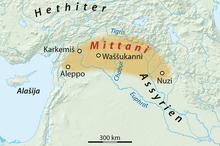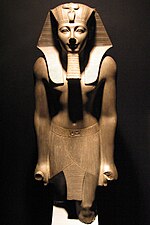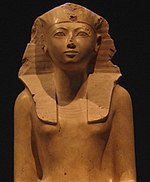15. Jahrhundert v. Chr.
Portal Geschichte | Portal Biografien | Aktuelle Ereignisse | Jahreskalender | Tagesartikel
◄ | 3. Jt. v. Chr. | 2. Jahrtausend v. Chr. | 1. Jt. v. Chr.
◄ | 17. Jh. v. Chr. | 16. Jh. v. Chr. | 15. Jahrhundert v. Chr. | 14. Jh. v. Chr. | 13. Jh. v. Chr. | ►
Das 15. Jahrhundert v. Chr. begann am 1. Januar 1500 v. Chr. und endete am 31. Dezember 1401 v. Chr.

Zeitalter/Epoche
- Mittelmykenische Zeit bzw. Späthelladikum II auf dem südlichen und zentralen griechischen Festland[1].
- Um 1500 v. Chr. wanderten die Arier vom Norden her in das heutige Indien ein und brachten die vedische Kultur, als sie sich mit den einheimischen Stämmen vermischten. Damit beginnt die frühvedische Zeit[2].
- Um 1450 v. Chr. beginnt die Nachpalastzeit auf Kreta[3].
- Die Bronzezeit umfasst in Mitteleuropa etwa den Zeitraum von 2200 bis 800 v. Chr. Die Mittlere Bronzezeit dauerte in Mitteleuropa absolutchronologisch etwa von 1600 v. Chr. bis 1300 v. Chr.
Ereignisse/Entwicklungen


- Ab dem 15. Jahrhundert v. Chr. sind die Olmeken im heutigen Mexiko nachweisbar[4].
- Anfang des 15. Jahrhunderts v. Chr. oder bereits Ende des 16. Jahrhunderts v. Chr. ist das Königreich Mittani in Nordsyrien entstanden[5].
- um 1493 v. Chr.: Thutmosis I. wird Regent von Ägypten; er errichtet als erster Regent sein Grab im Tal der Könige bei Karnak.
- um 1465 v. Chr. wurde Agum III. Herrscher von Babylonien. Er eroberte wahrscheinlich das südmesopotamische Meerland und danach die Insel Dilmun (vermutlich das heutige Bahrain)[6].
- 1457 v. Chr.: In der Schlacht bei Megiddo besiegen die Ägypter eine Koalition von Fürsten aus Retjenu.
- um 1450/1425 v. Chr. (nach traditioneller Chronologier): Mykenische Griechen erobern das minoische Kreta, die kretisch beherrschten Kykladen sowie das bis dahin zumindest teilweise kretisch besiedelte Rhodos und Milet.
- um 1445 v. Chr.: Frühe Datierung des Auszuges des Volkes Israel aus Ägypten nach 1 Kön 6,1 .
Persönlichkeiten
Hinweis: Die Regierungsjahre lassen sich in diesem Jahrhundert noch nicht genau bestimmen. Von daher handelt es sich um ungefähre Schätzungen.


Pharaonen von Ägypten
- Amenophis I. (1514–1493 v. Chr.)
- Thutmosis I. (1493–1482 v. Chr.)
- Thutmosis II. (1482–1479 v. Chr.)
- Hatschepsut (1479–1458 v. Chr.)
- Thutmosis III. (1458–1426 v. Chr.)
- Amenophis II. (1426–1400 v. Chr.)
Könige von Assyrien
- Puzur-Aššur III. (1502–1479 v. Chr.)
- Enlil-nasir I. (1478–1466 v. Chr.)
- Nur-ili (1465–1454 v. Chr.)
- Aššur-šaduni (1454 v. Chr.)
- Aššur-rabi I. (1453–1435 v. Chr.)
- Aššur-nadin-ahhe I. (1434–1421 v. Chr.)
- Enlil-nasir II. (1420–1415 v. Chr.)
- Aššur-nirari II. (1414–1408 v. Chr.)
- Aššur-bel-nišešu (1407–1399 v. Chr.)
König von Babylonien
- Burna-buriaš I. (1510–1490 v. Chr.)
- Kaštiliaš III. (1490–1465 v. Chr.)
- Agum III. (1465–1415 v. Chr.)
- Kara-indaš (1415–1403 v. Chr.)
- Kadašman-Ḫarbe I. (1403–1390 v. Chr.)
König von Elam
- Kidinu (um 1500 v. Chr.)
Könige des hethitischen Reiches
- Taḫurwaili (1500–1485 v. Chr.)
- Alluwamna (1485–1480 v. Chr.)
- Ḫantili II. (1480–1465 v. Chr.)
- Zidanta II. (1465–1450 v. Chr.)
- Ḫuzziya II. (1450–1430 v. Chr.)
- Muwattalli I. (1430–1420 v. Chr.)
- Tudḫaliya I. (1420–1400 v. Chr.)
Erfindungen und Entdeckungen
- Die Linear B-Schrift wird im 15. Jahrhundert v. Chr. von der mykenischen Kultur aus der älteren minoischen Linear A-Schrift entwickelt[7][8].
- Die Kypro-minoische Schrift wurde seit dem 15. Jahrhundert v. Chr. in Zypern benutzt[9].
- Im 15. Jahrhundert v. Chr. wurde in Ägypten Glas zu Gefäßen verarbeitet[10]. Wahrscheinlich wurde die Technik im Zuge der Expansionspolitik des Neuen Reiches aus Nordsyrien und Palästina importiert.
Weblinks
Einzelnachweise
- ↑ Mykene Peloponnes. In: kreta.com. Abgerufen am 18. Februar 2012.
- ↑ Geschichte: Indien. In: wissen-digital.de. Abgerufen am 18. Februar 2012.
- ↑ Andreas Schneider: Kreta. DuMont Reiseverlag, 2001, ISBN 3-7701-5601-3, S. 79
- ↑ Polte Marcel: 2012 Countdown der Apokalypse?. BoD – Books on Demand, 2010, ISBN 3-8423-2584-3, S. 10
- ↑ Klaas Veenhof: Geschichte des Alten Orients bis zur Zeit Alexanders des Grossen. Vandenhoeck & Ruprecht, 2001, ISBN 3-525-51685-1, S. 158
- ↑ Harriet Crawford & Michael Rice: Traces of Paradise: The Archaeology of Bahrain, 2500 BC to 300 AD. I.B.Tauris, 2005, ISBN 1-86064-742-1, S. 114
- ↑ Peter Hugoe Matthews: The concise Oxford dictionary of linguistics. Oxford University Press, 2007, ISBN 0-19-920272-9, bei G (Greek)
- ↑ Carl Knappett und Lambros Malafouris: Material agency: towards a non-anthropocentric approach. Springer, 2008, ISBN 0-387-74710-9, S. 147
- ↑ Üwe Hinrichs und Uwe Büttner: Handbuch der Südosteuropa-Linguistik. Otto Harrassowitz Verlag, 1999, ISBN 3-447-03939-6, S. 197
- ↑ Axel von Saldern: Antikes Glas. C.H.Beck, 2004, ISBN 3-406-51994-6, S. 30 ff
Auf dieser Seite verwendete Medien
(c) Postdlf, CC BY-SA 3.0
Detail of Hatshepsut, Eighteenth dynasty of Egypt, c. 1473-1458 B.C. Indurated limestone sculpture at the Metropolitan Museum of Art, New York City. Hatshepsut is depicted in the clothing of a male king though with a feminine form. Inscriptions on the statue call her "Daughter of en:Re" and "Lady of the Two Lands." Most of the statue's fragments were excavated in 1929, by the Museum's Egyptian Expedition, near Hatshepsut's funerary temple at Deir el-Bahri in Thebes. The lower part of the statue was acquired by Karl Richard Lepsius and taken to Berlin in 1845. The head, left forearm, and parts of the throne were excavated by the Museum, 1926-27 season and acquired in the division of finds. The Berlin fragment was acquired by the Museum in an exchange in 1929.
Tuthmosis III basalt statue in Luxor Museum.
His name on his belt in his cartouche is Men-kheper-Re; the 'Permanence-Transformation-(of)-Ra, and could be similar to: Steadfastly-[Becomeing-like]-Ra. In reality his name is: Mn-khepr-Re(a), assuming that is the only order of the pronunciation, or reading. (With Ra, first, his name could be: "Ra's Permanent Manifestation(transformation)". (And Note: Tuthmosis III became a local world power because of his foreign campaigns.-Called the Napoleon of Egypt.)
Autor/Urheber: Enyavar, Lizenz: CC BY-SA 4.0
Alter Orient um 1500 vor Christus: Ägyptische Expansion in Levante und Konkurrenz mit Hethitern und Mittani. Kaschiten im Konflikt mit Elam, Meerland / Minoische Eruption, mykenische Kultur kommt auf
Wissensstand der Karte entspricht geschichtlichen Wikipedia-Artikeln zu den dargestellten Städten/Reichen/Kulturen, sowie weiterer Kartenrecherche. Dokumentation der genutzten Quellen hier. Fragen/Unrichtigkeiten bitte (deutsch/englisch) melden bei mir oder im Talk der Basiskarte.
- Die Karte soll die ungefähren Einflussbereiche von Kulturen/Reichen der dargestellten Jahrhundertwende vermitteln. Exakte Grenzen sind nur selten überliefert, sodass Ungenauigkeiten möglich sind.
- Die Karte zeigt eine Auswahl wichtiger Siedlungen um die dargestellte Jahrhundertwende, beschriftet mit Namen von nach Möglichkeit in (lateinisch transkribierter) historischer Bezeichnung. Einige heute kaum gebräuchliche Namen werden ergänzt um [heutiger Name].
- Flüsse zeigen den heutigen Verlauf; moderne Stauseen wurden allerdings aus der Ansicht entfernt.
- Angenommen wird die Mittlere Chronologie






